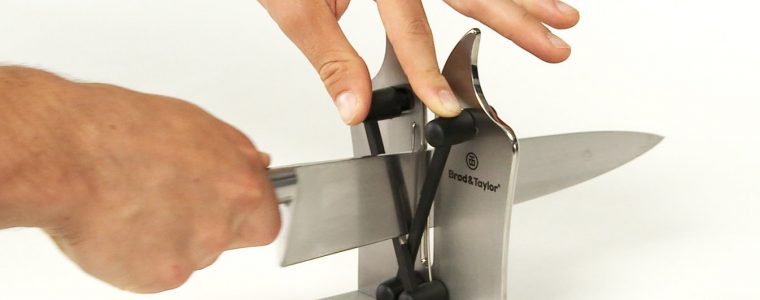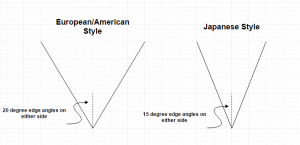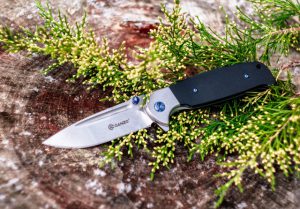
The Evolution Of Knife Sharpening
Rewind back a couple hundred years ago and you’d quickly realize things were done quite differently than they are today. If someone needed their knives to be sharpened, they’d most likely consult with a Moleta. These were skilled individuals who understood the art of knife sharpening. You’d find one around a street corner working on his trustworthy grind wheel. If you couldn’t afford to pay a Moleta, your next and only option was to learn how to sharpen on stone. Although we still use stones today, a lot has changed over the years. What are my choices for remedying a dull blade today?
- Electric Sharpeners – Usually the easiest and quickest solution to get a dull blade sharp. Typically tends to be more expensive though.
- Manual Sharpeners – The majority of these can be categorized as pull through knife sharpeners. This type of device is easy to use, and usually fairly inexpensive.
- Stones – Oil/water/diamond stones are the most common. Most enthusiasts live and die by the stone and will not use anything else. Requiring some practice and skill, sharpening on a stone is not easy as electric/manual. If used correctly, you can expect incredible results!
- Professional Services – Some people only trust the work of a professional. At a fixed rate, you can send your blades to be sharpened by a professional service.
The 4 options above are the most popular, and the best as far as results. Now that you have a basic understanding, let’s dive in and talk specifically about pull through knife sharpeners. This blog post is for anyone who is considering a pull through, and does not wish to pursue any of the other options listed above.
Anatomy Of Pull Through Knife Sharpeners – How Do They Work?
Before we talk about what you need to know before you get one, let’s first talk about how these things work. This device works exactly as it’s name suggests: you pull a blade through an abrasive from heel to tip, and repeat until you achieve sharpness. The more passes you make, the more steel is stripped off from your blade by the abrasive. That’s all there really is to it! The picture below shows how it’s done using the Brod & Taylor pull through sharpener.

Okay, we are now ready to talk about the 5 most important things you should consider before buying one. So without further ado!
#1 Understand Your Tool Before Working On It!
The most important thing you can do before buying anything is to fully understand why you’re buying it in the first place! Sounds intuitive and maybe even a little silly right? Not fully understanding why you need something is the reason many people end up disappointed. Allow me to explain by giving you an example…..Let’s say I need to expand the memory of my camera since I will need the extra space over my vacation in Europe. Okay, so I head over to the tech store and pickup a higher capacity memory card, and……oh crap! I chose an XD card instead of an SD card. I need an SD card since that’s what my camera will work with. Now I have to go all the way back to the store! Do you see my point, or is it not clear yet? Just like cameras, not all knives are the same. So you can’t expect to sharpen them the same! When I say understand your tool before working on it, I basically mean understand your knives before going out and buying a sharpener to work on them. Here are some things you should understand beforehand:
- Thick Or Thin? – Concerning the blades you will need to sharpen, can you categorize them as a thicker Western style or a thinner Asian style? Usually, knife makers life Wusthof and Henckels forge their blades to have thick 20 degree edges. In contrast, Asian knife makers like Global have scary sharp 10-15 degree edges. Your homework is to see if you can categorize your knives as thick or thin. Knowing this will help you select a pull through knife sharpener that best works for what you have.

- What’s It Made Of? – Well, steel of course! Yes, that’s correct but can you go a step further and find out the hardness (AKA Rockwell number often designated as “HRC”)? Knowing the hardness of your steel could be very beneficial in deciding which sharpener to select. Why you ask? Okay, let’s look at an example. Suppose you own a set of blades that has an HRC of 62 (considered a very hard knife), this tells you 2 things: one is that you’ll probably not need to sharpen it often, since a harder steel will typically retain its edge longer, and two, you’ll need to be sure that the pull through you select has abrasives hard enough to work on this steel. Don’t take this as a given! Some pull through knife sharpeners use steel to abrade, and this may not suffice for a really hard blade. If you’re wondering about ceramic blades, that’s a discussion on its own. Click here to see my thoughts.

Knowing How Hard Your Steel Is Can Help In Choosing The Right Sharpener
#2 How Much Are You Willing To Spend?
One of the biggest reasons people go for pull through knife sharpeners instead of any other system is because of how reasonably priced they are. However, you’ll still need to do your homework and determine how much you’re willing to spend. Here’s some perspective on price range: you can find them as cheap as $6, and as expensive as $120. Again, it doesn’t necessarily mean that the more expensive one is better than the cheaper one. You’ll have to dig deeper, read reviews, and research products in order to understand what to pursue and what to avoid. Now that you have an idea for price range, you can hopefully set yourself a budget.

#3 Abrasives – What’s Right For You?
Abrasives are the most important component in pull through sharpeners. They abrade a knife’s steel, thereby restoring a dull edge to a sharp one. A good abrasive will only remove minimal metal and in a less aggressive manner. A poor abrasive can potentially remove excess steel and even scratch, chip and nick a blade. So how can you pick the right abrasive? As a rule of thumb, I prefer hardened steel abrasives over anything else like ceramic (or its derivatives), or even diamond (rare to see in pull throughs). Hardened steel is actually less harder than the others, which means it will strip away much less steel from my knife, during sharpening. However, if you’re working with knives that have high HRC numbers, hardened steel won’t work as well. Another thing you will want to consider is if you will need to replace abrasives. And if so, how long do they typically last, and the cost of replacement. Take your time to think it through, and remember: the goal is to remove as little metal as possible while still forging a wicked edge.

#4 Size – Will You Be Carrying & Using This On The Go?
One thing you should know is that these things come in all shapes and sizes. Some pull throughs are even small enough to fit in the palm of your hand. The question, however, is how important is size to you? For some people it’s absolutely necessary since they need something that is easy to carry while hunting, fishing, and camping. For other people, it makes zero difference, and they’d be fine with a less compact option. What matters to you?
#5 Time To Investigate Further!
Once you’ve narrowed down your list to a handful of pull through knife sharpeners, it’s time to get busy researching! This is the part where you start reading reviews and watching product demonstrations on YouTube. Make sure you read lots of reviews so you are able to really get a good understanding of the device beforehand. Remember that reviews are subjective and tend to be opinionated, so reading a lot of them will give you a much better idea than reading just one or two. Also, you can find some really good information in product instruction manuals. These often contain a frequently asked questions (FAQs) section, as well as a step by step guide on how to operate. Lastly, call or email the product manufacturer for any final questions or clarifications.
Final Words
There you have it! I hope this guide helps you find a pull through sharpener to suit your needs. If there’s one thing I’d like to reiterate, It’s that understanding your tools before working on them can save you a lot of cash and disappointment. Finally, if you have any questions, comments, or thoughts, please let me know and I’ll be happy to answer. Thanks again for reading, and I hope you have an awesome day (or night!).
